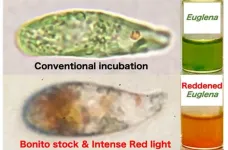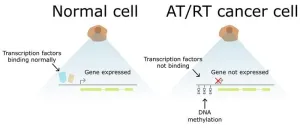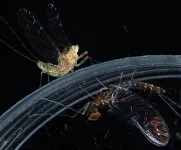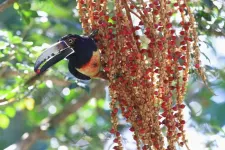MEDIA INQUIRES
WRITTEN BY
Laura Muntean
Ashley Vargo
laura.muntean@ag.tamu.edu
ashley.vargo@ag.tamu.edu
601-248-1891
Depiction of bacteriophage PP7 (orange) at the cell surface of Pseudomonas aeruginosa detaching the bacterium’s pilus (blue). The researchers identified protein structures and interactions using fluorescence microscopy, cryogenic-electron microscopy and computational simulations. This image is derived based on the findings from the team. (Jirapat Thongchol/Texas A&M AgriLife)
Bacterial infections pose significant challenges to agriculture and medicine, especially as cases of antibiotic-resistant bacteria continue to rise. In response, scientists at Texas A&M AgriLife Research are elucidating the ways that bacteria-infecting viruses disarm these pathogens and ushering in the possibility of novel treatment methods.
In their recent study published in Science, Lanying Zeng, Ph.D., a professor, and Junjie Zhang, Ph.D., an associate professor, both in the Texas A&M College of Agriculture and Life Sciences Department of Biochemistry and Biophysics, detailed a precise mechanism by which phages disable bacteria.
The collaborative effort also involved:
Yiruo Lin, Ph.D., research assistant professor in the Texas A&M College of Engineering Department of Computer Science and Engineering.
Matthias Koch, Ph.D., assistant professor in the Texas A&M College of Arts and Sciences Department of Biology.
Zemer Gitai, Ph.D., and Joshua Shaevitz, Ph.D., professors in the Princeton University Department of Molecular Biology and Department of Physics, respectively.
Yinghao Wu, Ph.D., associate professor in the Albert Einstein College of Medicine Department of Systems and Computational Biology.
Together, the team worked to explain a series of interactions scientists have sought to understand since the early 1970s.
The need for new treatments
Pseudomonas aeruginosa is a type of bacteria that can cause infections in the blood, lungs and occasionally other parts of the body. These infections are especially common in healthcare settings, which often encounter drug-resistant bacteria. According to the Centers for Disease Control and Prevention, there were over 30,000 cases of multi-drug resistant P. aeruginosa infections among hospitalized patients in 2017.
The prevalence of antibiotic-resistant Pseudomonas infections makes them a practical point of focus for phage therapy, a type of treatment method using bacteriophages, or phages, that researchers at the Texas A&M Center for Phage Technology are exploring as an alternative to typical drugs.
Zeng and Zhang, co-directors at the center along with Jason Gill, Ph.D., associate professor in the Department of Animal Science, are exploring the usefulness of phages, even beyond phage therapy, by diving into the structures and mechanisms at play.
Targeting the pilus
One of the factors that allows P. aeruginosa to transmit antimicrobial-resistant genes among each other, as well as move around and create difficult-to-treat structures called biofilms, is an appendage called a pilus, named after the Latin word for spear. These cylindrical structures extend from the surface of bacteria.
Some phages make use of bacterial pili by attaching to them and allowing bacteria to reel the phage to the surface, where the phage can start infecting the bacteria.
In their study in Science, co-first authored by Texas A&M graduate students Jirapat Thongchol and Zihao Yu, the researchers studied this process step by step using fluorescence microscopy, cryogenic-electron microscopy and computational modeling. They observed how a phage called PP7 infects P. aeruginosa by attaching to the pilus, which then retracts and pulls the phage to the cell surface.
At the point of entry for the virus, the pilus bends and snaps off, and the loss of the pilus makes P. aeruginosa much less capable of infecting its own host.
Ongoing research
This work is a continuation of previous research published in 2020, when Zeng’s team found a phage that can similarly break off the pili of E. coli cells, preventing the bacteria from sharing genes among each other — a common way that antibiotic resistance spreads.
From left to right: Lanying Zeng, Ph.D., Junjie Zhang, Ph.D., Zihao Yu and Jirapat Thongchol. Along with others, these researchers at the Texas A&M Center for Phage Technology are searching for solutions to antibiotic-resistant bacterial infections and characterizing phage-bacterium interactions. (Zihao Yu/Texas A&M AgriLife)
The Science study on Pseudomonas is part of the team’s recent suite of research studies. Last month, they published findings in Nature Communications on the interaction between another genus of bacteria, Acinetobacter, and a phage that infects it. Another study, expected to be published next month, will cover a third genus of bacteria and additional phage.
The team’s progress in determining precise protein structures and molecular interactions has been made possible with AgriLife Research’s new cryo-electron microscope, which opened at Texas A&M at the end of 2022 and can resolve structures at the atomic level.
“In our earlier study on E. coli, we did not really explore much about the mechanism,” Zeng said. “In our study of Pseudomonas, we were able to explain much more about what exactly is going on, including the force and speed of pilus detachment, and understand why and how this happens.”
Uses in medicine
The implications of this ongoing research could prove to be important in treating antimicrobial infections. Zhang said doctors wouldn’t need to use phages to kill the bacteria — as is done in phage therapy — but could simply allow the viruses to disarm the bacteria, which may give the immune system the chance to fight the infection on its own or allow doctors to treat patients with lower doses of antibiotics.
“If you simply kill the bacteria, you break the cells, and they’re going to release toxic material from inside the cell into the host,” Zhang said. “Our approach is to use a particular type of phage that disarms the bacteria. We remove their ability to exchange drug-resistance genes or to move around by breaking off this appendage.”
The team of phage scientists said they will continue looking for similar instances of phages dampening the virulence of pathogenic bacteria.
“We’re taking a synergistic approach,” Zhang said. “We’re trying to understand a universal mechanism for this type of phage and how they’re capable of affecting other types of bacteria. That’s the overall aim of our collaborative effort: to try to tackle the problem of multi-drug resistant bacteria.”
-30-
Would you like more information from Texas A&M AgriLife?
Visit AgriLife Today, the news hub for Texas A&M AgriLife, which brings together a college and four state agencies focused on agriculture and life sciences within The Texas A&M University System, or sign up for our Texas A&M AgriLife E-Newsletter.
For more resources including photo repository, logo downloads and style guidelines, please visit the Resources for Press and Media.
END






